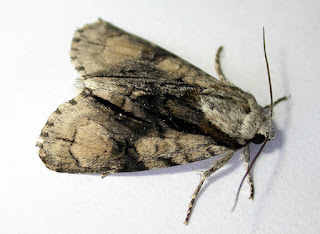My garden trap last night was much more productive that the previous two evenings - still no sign of any migrants though!
I have a couple of queries. Firstly, this rather fresh Endothenia is a new one for me, but I'm undecided as to which one. It looks likely to be marginana or gentianaeana, though both are supposed to be on their way out by now, both sides shown below.
Edit: actually having now had a closer look, I think it is most likely Endothenia oblongana, the length, which I should have posted earlier, supports this as well being about 7mm. I was swaying back to marginana, but went to check the hindwings, which are supposed to be obviously white in marginana. They appeared very dark, both upper and lower, which again supports oblongana. The late date seems odd though - perhaps another double brood?
Secondly, can this Caloptilia be safely distinguished from this photo? I think it looks a likely betulicola.
Edit: I suspect that this is one for you Peter.
The following is just my indulgence as I had quite a few new species for my garden list, though none of them particularly exciting: Deep-brown Dart, Scrobipalpa costella, Choreutis pariana and Tachystola acroxantha. Also, having only just added Achroia grisella, another specimen turned up.
I should have included photos of the two Merveille du Jour that turned up, as best looking of the night, but as they are regular Autumn moths I didn't take any, just these brown things above....
Adam Bassett
Marlow Bottom






















